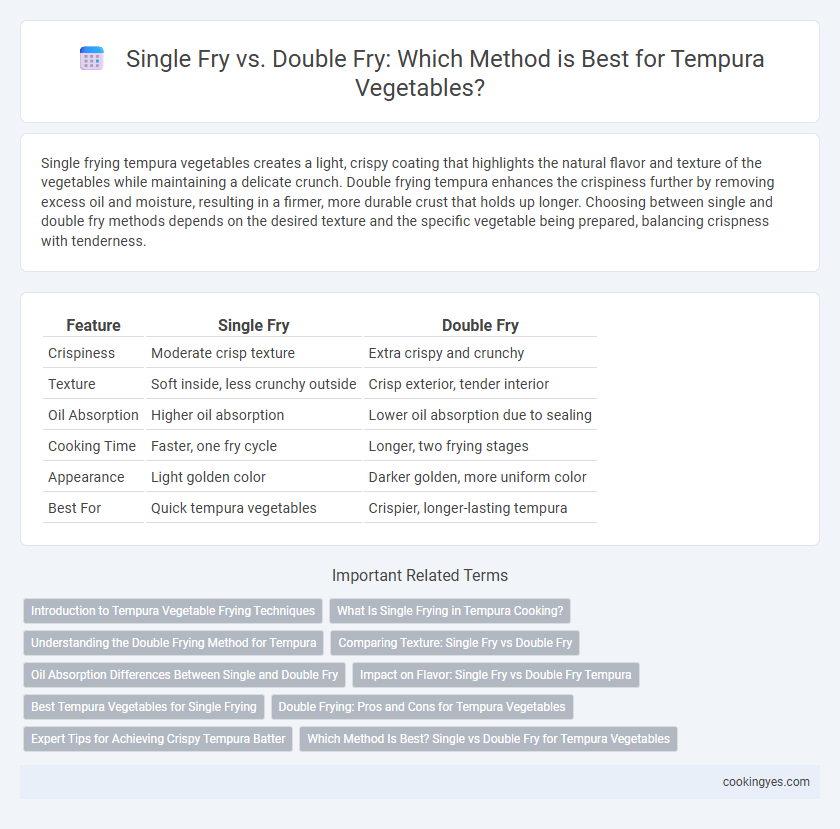Single frying tempura vegetables creates a light, crispy coating that highlights the natural flavor and texture of the vegetables while maintaining a delicate crunch. Double frying tempura enhances the crispiness further by removing excess oil and moisture, resulting in a firmer, more durable crust that holds up longer. Choosing between single and double fry methods depends on the desired texture and the specific vegetable being prepared, balancing crispness with tenderness.
Table of Comparison
| Feature | Single Fry | Double Fry |
|---|---|---|
| Crispiness | Moderate crisp texture | Extra crispy and crunchy |
| Texture | Soft inside, less crunchy outside | Crisp exterior, tender interior |
| Oil Absorption | Higher oil absorption | Lower oil absorption due to sealing |
| Cooking Time | Faster, one fry cycle | Longer, two frying stages |
| Appearance | Light golden color | Darker golden, more uniform color |
| Best For | Quick tempura vegetables | Crispier, longer-lasting tempura |
Introduction to Tempura Vegetable Frying Techniques
Single fry tempura vegetables achieve a light, crispy texture by briefly immersing them in hot oil once, ensuring a delicate batter coating that highlights the vegetable's natural flavor. Double fry tempura vegetables involve frying them twice, first at a lower temperature to cook the vegetable through and then at a higher temperature to enhance crispness and reduce oil absorption, resulting in a crunchier and less greasy texture. Mastering these frying techniques is essential for achieving the perfect tempura balance of crispy exterior and tender interior.
What Is Single Frying in Tempura Cooking?
Single frying in tempura cooking involves immersing vegetables briefly in hot oil at temperatures ranging from 160degC to 180degC, ensuring a light, crispy batter without absorbing excess oil. This method preserves the natural texture and moisture of vegetables like sweet potatoes, green beans, and eggplant by cooking them evenly with a delicate, airy crust. Single fry is preferred for tempura to achieve an ideal balance of crunchiness and freshness, enhancing the dish's traditional Japanese flavor profile.
Understanding the Double Frying Method for Tempura
Double frying tempura vegetables enhances crispiness by first cooking at a lower temperature to gently remove moisture, followed by a second, hotter fry that creates a golden, crunchy exterior. This method prevents sogginess common in single frying, preserving the vegetable's freshness and texture. Optimal oil temperatures typically range from 160degC (320degF) for the initial fry to 180degC (356degF) for the final crisp finish.
Comparing Texture: Single Fry vs Double Fry
Single fry tempura vegetables deliver a light, delicate crispness with a tender interior, preserving the natural texture of the vegetable. Double fry tempura enhances crunchiness and creates a thicker, more robust crust that better resists sogginess over time. Comparing texture, single fry tempura offers a softer bite, while double fry tempura achieves a more substantial, prolonged crispiness.
Oil Absorption Differences Between Single and Double Fry
Single fry tempura vegetables absorb more oil due to prolonged contact with hot oil, resulting in a greasier texture and heavier mouthfeel. Double frying tempura reduces oil absorption by initially cooking the batter and then briefly frying again at a higher temperature, creating a crispier, lighter coating that repels excess oil. This technique enhances the crunchiness and decreases overall oiliness, making double-fried tempura a healthier, more appealing choice for vegetable dishes.
Impact on Flavor: Single Fry vs Double Fry Tempura
Single fry tempura vegetables retain a light, crispy texture with a delicate flavor that highlights the natural sweetness of the vegetables. Double frying tempura enhances the crunchiness, creating a thicker, crunchier crust that intensifies the overall flavor profile by adding a richer, toasted note. The choice between single and double fry impacts the balance between subtle vegetable taste and robust, crispy texture in tempura dishes.
Best Tempura Vegetables for Single Frying
Single frying tempura vegetables ensures a light, crispy texture while preserving the delicate flavors and moisture of ingredients like asparagus, sweet potato, and eggplant. Vegetables with higher moisture content or a tender structure benefit from a single fry to avoid sogginess or overcooking. Single frying is ideal for tempura vegetables that cook quickly, enhancing their natural sweetness and maintaining an airy batter.
Double Frying: Pros and Cons for Tempura Vegetables
Double frying tempura vegetables enhances crispiness by creating a firmer outer layer that retains moisture within, resulting in a crunchier texture compared to single fry techniques. However, double frying increases oil absorption, which may lead to a greasier taste and higher calorie content. This method requires precise temperature control between fries to prevent overcooking or burning, making it less forgiving but superior for achieving extra crispiness.
Expert Tips for Achieving Crispy Tempura Batter
Single fry tempura vegetables offer a light, delicate crispness that highlights the natural flavors, while double frying enhances crunchiness and extends texture retention by removing excess moisture. Expert tips for achieving crispy tempura batter include maintaining cold batter temperatures, using ice water, and ensuring oil is heated to a consistent 340-360degF (170-182degC). Using lower protein flour like cake flour and avoiding overmixing also contribute to a crispier, lighter tempura coating.
Which Method Is Best? Single vs Double Fry for Tempura Vegetables
Single fry tempura vegetables retain a lighter, crisp texture with a delicate batter that highlights the natural flavors of the vegetables without becoming too oily. Double fry tempura vegetables result in an extra-crisp, more robust crust that holds up better to dipping sauces and prolonged serving times, but may slightly overpower the vegetable's tenderness. For optimal tempura texture, single frying suits fresh, tender vegetables, while double frying is ideal for thicker, moisture-rich produce needing extra crunch.
Single fry vs double fry for tempura vegetables Infographic

 cookingyes.com
cookingyes.com